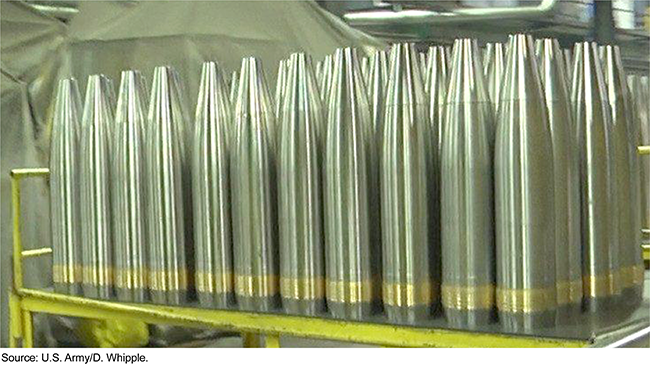Ukraine: Status and Challenges of DOD Weapon Replacement Efforts
Fast Facts
The Department of Defense gave Ukraine billions of dollars' worth of weapons from its stockpiles to help respond to Russia's 2022 invasion. Our Q&A report looks at how DOD spent the $25.9 billion in supplemental funding that Congress provided to replenish the stockpiles.
Ammunition, missiles, and combat vehicles account for most of this spending. DOD is also using some of the funding to expand production capacity in the defense industrial base (the companies that develop and manufacture weapon systems). For example, DOD is investing $2 billion of this funding to help companies get materials to increase the production of 155mm ammunition.
155mm artillery shells

Highlights
What GAO Found
The Department of Defense (DOD) provided Ukraine with billions of dollars’ worth of weapons from its stockpiles to help respond to Russia’s full-scale invasion in 2022. As of March 2024, Congress provided $25.9 billion in supplemental funding that DOD can use to replace these weapons.
DOD obligated more than 70 percent of this funding—over $18 billion—as of December 31, 2023. Over $16 billion was obligated for the procurement of weapons and industrial base expansion, while the remainder was obligated to reimburse DOD transportation and logistics costs. Ammunition, missiles, and combat vehicles account for most of these obligations, as shown below.
Procurement Obligations for Supplemental Replacement Funding by Defense Industrial Base Sector, as of December 2023

Note: The DOD Comptroller subsequently updated the data to correct some internal reprogramming actions that were inaccurately recorded, which could result in some variations in the dollar values presented in the figure.
DOD requested an additional $18 billion in supplemental funding beyond the $7.7 billion that remains unobligated to continue replacing weapons transferred to Ukraine. In April 2024, Congress passed legislation to provide DOD about $13.4 billion that may be used to replace weapons sent to Ukraine.
DOD identified multiple supply chain challenges that weapon programs are experiencing. Generally, these are long-standing challenges made worse by events such as the COVID-19 pandemic and increased demands from Ukraine, among other factors. Long lead times associated with the delivery of supplier parts and raw materials are affecting many weapons programs. One missile program that GAO reviewed reported a lead time increase from 19 to 34 months within the last 2 years for electronic parts, such as circuit card assemblies.
To address these challenges, DOD is using some of the $25.9 billion that Congress provided to expand the defense industrial base’s production capacity. Since February 2022, DOD has committed or obligated over $2.8 billion to increase weapons production. For example, DOD is using nearly $2 billion of this funding to drive a sevenfold increase in 155mm ammunition production.
DOD is also relying on multiyear procurement, a contracting approach that provides up to 5 years of requirements through one contract. Multiyear procurements can benefit the industrial base by providing a stable demand signal up front. This can drive cost savings for the government. For example, DOD can generate discounted pricing by purchasing multiple years’ worth of supplies at once.
The military departments awarded or plan to award multiyear procurement contracts to help replace five types of weapons provided to Ukraine. However, DOD officials and contractor representatives told GAO that they face challenges implementing this authority. Some suppliers are reluctant to enter into long-term agreements that lock them into certain prices across multiple years.
DOD is collecting lessons learned based on its first-time use of supplemental funding for replacement. These include observations on challenges and solutions for using multiyear procurement contracts, among other things.
Why GAO Did This Study
In response to Russia’s invasion of Ukraine in February 2022, Congress appropriated supplemental funding to assist Ukraine. Of the more than $113 billion under four Ukraine supplemental appropriations acts as of November 2023, $25.9 billion can be used by DOD to replace weapons transferred to Ukraine, such as missiles and ammunition
The defense industrial base—the companies, people, and facilities needed to produce and sustain weapons—will need surge production to replenish DOD’s stocks, in addition to meeting other increased demands. DOD previously identified risks in 2018 and during the COVID-19 pandemic that may limit the defense industrial base’s ability to do so.
Public Law 117-328 includes a provision for GAO to monitor DOD’s use of Ukraine supplemental funding. This report provides information on DOD’s use of the $25.9 billion to replace weapons sent to Ukraine and actions DOD is taking to address defense industrial base challenges that could delay replacement efforts.
To perform this review, GAO analyzed DOD data and documentation as well as interviewed DOD officials and contractor representatives. GAO also conducted case studies of four weapons in the missile and combat vehicle sectors.
For more information, contact W. William Russell at (202) 512-4841 or RussellW@gao.gov.
